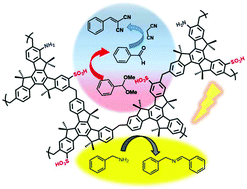Truxene-based porous polymers: from synthesis to catalytic activity†
Abstract
We report a multigram synthesis of new, robust, insoluble porous organic polymers based on the semiconducting platform of hexamethyltruxene (TxPPs and TxBnPPs) which present high Brunauer–Emmett–Teller (BET) specific surface areas (1710–1186 m2 g−1). These new polymers exhibit high thermal and chemical stability and can be easily postfunctionalized under different reaction conditions, allowing the incorporation of acid, base or acid–base groups (TxPPs-SO3H, TxPPs-NH2 and TxPPs-SO3H–NH2) in the polymeric networks, yet displaying a significant porosity. The potential applications of the new truxene-based polymers as heterogeneous catalysts are also presented. The intrinsic photocatalytic activity of the truxene network which takes advantage of the semiconducting character of the constituent units is investigated in the aerobic oxidative self-coupling of benzylamine under visible light. On the other hand, the use of these polymers as heterogeneous supports is investigated by studying the catalytic behavior of the monofunctional acid or bifunctional acid–base polymers in esterification and transesterification and one-pot cascade reactions, respectively.



 Please wait while we load your content...
Please wait while we load your content...